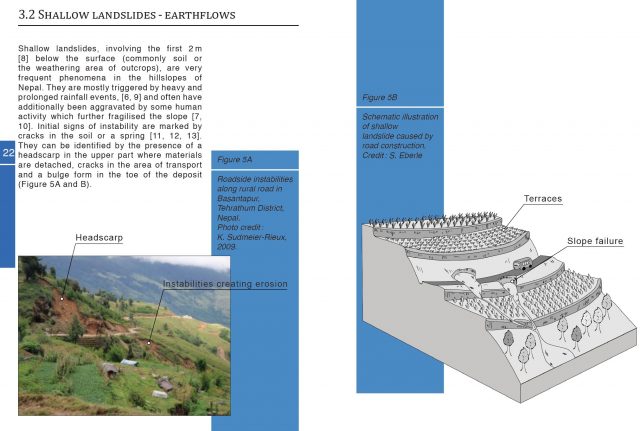9 April 2019
Eco-Safe Roads – resources to guide construction
Posted by Dave Petley
Eco-Safe Roads – resources to guide construction
Following my recent post on the need for properly engineered roads in high mountain areas, such as Nepal, Karen Sudmeier contacted me to highlight the work that she and her colleagues have undertaken on eco-safe roads. This work is featured in a piece on the IUCN website, featuring the use of bioengineering for improving slope stability along mountain roads. Bioengineering is not new, and can be highly effective, but its use remains disappointingly patchy.
The most useful element of this work is a manual that they have produced entitled “Community-based bio-engineering for eco-safe roadsides in Nepal”, which aims to provide “guidance to communities and local government agencies on the occurrence, assessment and mitigation of road construction-induced landslides and erosion.” The guide can be downloaded as a PDF.
This is a genuinely fantastic document, free of technical jargon, that both identifies the issues and offers really positive guidance on how to manage them. The first part of the document describes, with diagrams, the types of hazards that might be encountered. For example, this is the section that explains the hazards associated with earthflows:-

The hazards associated with earthflows, the guidelines for eco-safe roads. Reference:- Devkota et al. (2014).
.
The guidelines then provide a very helpful classification tool for measures to be considered:-

Recommended approaches for the design of eco-safe roads. Reference: Devkota et al. (2014).
.
Each of the techniques are then described in detail, including guidance on how to do it, the requirements, the advantages, the functions and the disadvantages / limitations.
I think this is a very helpful, very pragmatic set of guidelines that, if implemented, could make a huge difference. The guidelines can also be adapted easily for other locations / territories, in particular through the use of local plant species. They deserve wider recognition.
Reference
Devkota, S., Sudmeier-Rieux, K., Penna, I., Eberle, S., Jaboyedoff, M., Adhikari, A. and R. Khanal (2014) Community-based bio-engineering for eco-safe roadsides in Nepal. Lausanne : University of Lausanne, International Union for Conservation of Nature, Nepal and Department of Soil Conservation and Watershed Management, Government of Nepal.


 Dave Petley is the Vice-Chancellor of the University of Hull in the United Kingdom. His blog provides commentary and analysis of landslide events occurring worldwide, including the landslides themselves, latest research, and conferences and meetings.
Dave Petley is the Vice-Chancellor of the University of Hull in the United Kingdom. His blog provides commentary and analysis of landslide events occurring worldwide, including the landslides themselves, latest research, and conferences and meetings.
A rather worthful attempt! But is it possible that the slope inclination in degree is a mistake and the author means percent? A slope of 50 degree is no longer a slope but a subvertical rock face.
Thank you Dave.
Looking forward to feedback – there is always room for improvement!
Karen and team
We have a publication used extensively on the North Coast of California written with ranchers and other land managers specifically in mind. It has been recently revised and greatly expanded since its release 20+ years ago:
Weaver, W.E., and Hagans, D.K., 2014, Handbook for Forest, Ranch, and Rural Roads: A Guide for Planning, Designing, Constructing, Reconstructing, Upgrading, Maintaining and Closing Wildland Roads; Mendocino County Resource Conservation District in cooperation with California Department of Forestry and Fire Protection, and California State Water Resources Control Board, 420p.
Free download (45MB):
https://www.pacificwatershed.com/sites/default/files/RoadsEnglishBOOKapril2015b.pdf
or contact “[email protected]” to order a bound copy for $35.00 USD.
I know the authors, and have worked with them and their staff off and on since 1995 on forest road issues as a timber harvest regulator. Use of the the “Handbook” has visibly changed the face of rural road construction and helped to improve fisheries here in a very real way during my time here.
This one is older, and has a geotechnical emphasis:
Gray, D.H. & Sotir, R. (1996). Biotechnical and Soil Bioengineering Slope Stabilization. John Wiley & Sons: New York
Have these methods really been tried and proven? Or are they just someone’s idea of something that ought to be true?
The manual’s illustrations all show a nice, almost level stretch of road traversing a hillside. My (limited) experience indicates that problems are most likely to occur when the road is sloping up/down the hillside. In such cases the normal cross-fall (or camber) is ineffective in heavy rainfall events. While a 1:30 cross-fall may be adequate for a flat road, in a case where the road is sloping longitudinally at 1:5, the longitudinal slope completely dominates and the water will flow straight along the line of the road. So, instead of flowing off to the side (and into regularly spaced culverts), the runoff uses the roadway itself as a (very effective) channel. The flow will then concentrate on a single point or culvert where the gradient or alignment changes. Then, either the road gets washed away, or the hillside is scoured by a head-cutting ravine.